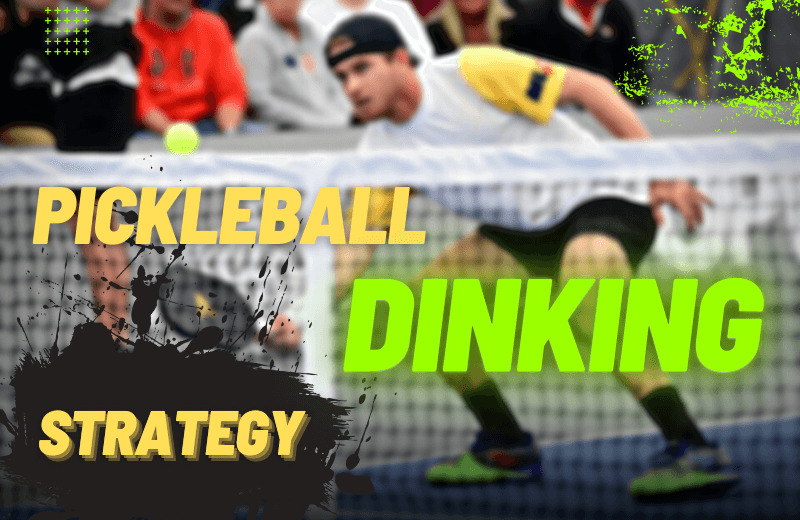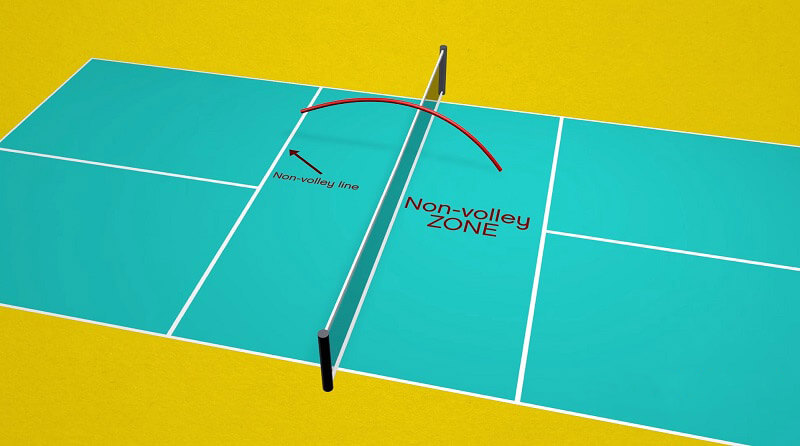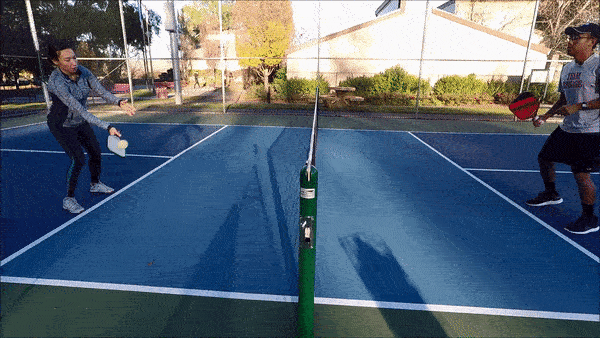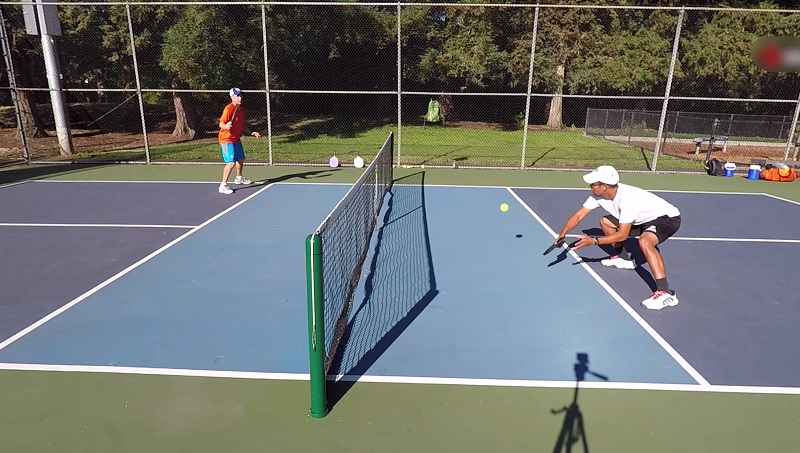Pickleball Dinking Strategy: Ditch the Dead Dinks
Dinking is one of the most important pickleball strategies to master. The first step of this pickleball dinking strategy is to stop hitting flat, or dead dinks. If you don’t know what a dead dink is, it’s a dink that has little to no spin in it and is hit at the same place every time. Although it technically passes as a dink, it doesn’t put the amount of pressure needed that makes a good dink really useful.
Additionally, they also tend to bounce a little too high, which makes it way too easy for the opponent to hit the ball. One good thing about flat dinks, however, is how consistent they are. Because of this same consistency, these types of dinks are more than useful when wanting to keep a rally going, the issue is that you won’t be able to get an easy point.
On the contrary, giving a high dink to the opponent in a rally will, in turn, give them an opportunity to speed their own return up every time, because the dinks will continue to go directly to them every single time.
Luckily, there are a couple of things you can do to make it so you don’t hit dead dinks.
Make the Location Unpredictable
Of course, if you keep hitting your shots at the same place every single time, then the opponent will start getting used to it. What you instead want to do is change the location the ball lands up a bit.
Try hitting it towards the left once, then the right, then the body, then the right again. Make the opponent have to hit with their forehand and backhand too. Make them have to move a short distance to be able to successfully receive your dink.
The word you need to remember above all else is unpredictability. Don’t ever let the opponent know your next move.
Mix up the Depth of the Dink
Similar to how the direction should be mixed up, so should the depth. Sometimes you might want to make the ball land closer to the net, while other times you might make it go closer to the opponent’s feet.
This way, the opponent will always have to think for a second whether they want to hit the ball while it’s in the air, or if they should let it bounce once first. In a game like a pickleball, where every second counts, even this second might be enough to turn the tides of the game in your favor.
Add Spins to Your Dink
Finally, perhaps the most critical difference between a dead dink and a good dink is that a good dink has a spin to it. Of course, this can be topspin, underspin, and/or sidespin.
Well, way to say this, but if you’re dinking from close to the net, you won’t really have the space to add any spin to it. Therefore, this strat usually only works when it comes to cross-court dinks (opposite side of the court when compared to the opponent.)
Pickleball Dinking Strategies
Pickleball dinking is all about focus and adaptability with a little bit of skill added to it. Luckily, if a good pickleball dinking strategy is what you’re looking for, then we have a bunch that will definitely improve your pickleball dinking.
1. Don’t be Afraid to Apply Pressure
The biggest reason for the popularity and usage of dinking in pickleball is that it puts so much pressure and stress on an opponent, that few techniques can even think of coming close.
Therefore, our most prioritized strategy is to be as aggressive as possible in order to apply pressure on the opponent. Don’t let them relax even for a moment. If they manage to return one of your dink, then hit another one, this time make it faster, make it more unpredictable, and give it more of a spin.
Of course, this doesn’t mean you should be aggressive every time. If you feel like hitting a dink will put you in an unfavorable position, or you won’t be able to get the ball over the net properly, then start playing easy.
2. Practice Patience
This pickleball dinking strategy directly correlates to the one before this. Although applying pressure and being aggressive at the right time is well and good, you can’t expect every shot to be a good chance for you to return with a dinking pickleball.
There will be times when you’ll have to wait for the right opportunity to strike, as you patiently try to set up the perfect shot for yourself. Remember, a pickleball match usually lasts between 15 and 25 minutes, not 2 and 5 minutes. Getting impatient or restless will only hurt your chances of winning.
Similarly, if the opponent hits an extremely aggressive dink toward you and your partner (maybe it has a lot of power/speed, is spinning, or is coming toward you at an awkward angle) It’s okay to return it with a passive and defensive dink. After all, what good is an aggressive dink if you can’t get it over the net?
Of course, we don’t want you to be so patient that you miss your opportunity to strike either. Eventually, the opponent will hit a dead dink to you, and when they do, that’s when you’ll have the chance to respond with an aggressive dink.
3. Try to Hit the Pickleball In the Air
Although this is something that pickleball players will most likely already do, one of the best pickleball dinking strategy is to hit the ball while it’s in the air instead of letting it bounce on your side of the court.
This is because doing this cuts down the time the opponent has to react to your dink and helps apply pressure on them. Not only that, but by hitting the ball in the air you’ll be able to stop any weird angle buildups or potential spins that could have shown after hitting the ground.
Naturally, this doesn’t mean you should hit the ball in the air every single time. If you feel like you’ll have to overexert yourself a little too much to get that first hit in, we suggest you just let it bounce once.
4. Take Full Advantage of the Bounce
Expanding on the previous point a little more, if you aren’t able to hit the pickleball in the air and it ends up bouncing, then you have two things you can do.
The first thing is waiting for the ball to reach its highest point after the boss, as then it’ll be the easiest for you to counter with an aggressive pickleball dink. However, this will most likely give the opponent more than enough time to catch their bearings and get their head back in the game to react to your receive.
The other thing you can do, however, is hit the ball as SOON as it bounces instead of waiting for it to hit the highest point. Although this is a little tricky and can oftentimes backfire, when done correctly you’ll still be successful in cutting the opponent’s reaction time in half.
5. Ensure You Don’t Hit Flat Dinks
Remember how we talked about flat dinks a while back, and what to do if you want to stop hitting them? Well, one of the most important strategies when it comes to hitting good pickleball dinks is mixing your dinks up.
Of course, there’s everything we talked about before, namely
- Continuously adjust the speed and power.
- Add spins to the pickleball when dinking.
- Try to hit at tight angles when possible.
- Don’t always make it land near the net. Try to aim it toward the opponent’s legs sometimes too.
- Keep on changing the direction of the pickleball dink. Left, right, and even toward the opponent’s body. Make your opponent move and have to hit backhands and front hands both.
6. Mix up Your Dinking: Expanding Dinking Strategy
In addition to mixing up the direction and angle of the dink, you should also shuffle through the different types of dinks that are available to you. This increases the unpredictability factor, which is perhaps the most important thing in a match of pickleball.
Cross Court Dink
The first type of dink is, of course, a cross-court dink. This is the most common type of dink because of how easy it is to pull off perfectly. You’re able to utilize tight angles and spin easily because of the time and space you have to pull them off.
Down the Line Dink
Next come down the line dinks, which, although more difficult to pull off, have a higher potential to catch the opponent off guard than cross court dinks. This is because of the reaction time these shots cut off the enemy.
Instead of going for cross-court dinks all the time, it might be easier and more unpredictable to go down the line and simply push the pickleball over the net in front of you. However, pick your opportunities carefully, as your opponent may be anticipating and waiting for your down the line. After all, some more seasoned players are able to successfully pull off an erne shot (Where they jump off of the court).
Middle Dink
If you find yourself against a seasoned player who can pull off Erne shots, consider going for middle dinks instead. Middle dinks cause confusion and panic amongst the enemy teammates, and are generally more effective when mixed in with cross-court and down the line dinks.
After all, picture this. You’re continuously hitting down the line and cross court dinks when suddenly you go for a middle dink. To receive it, both the opponent team members go towards the middle, opening up the sidelines for you to dink towards and get an easy point.
Dinks to Backhand
Just like table tennis and regular tennis, hitting the ball in a way that the opponent has to receive with their backhand is a viable strategy. This is because players typically have a weaker backhand, and as such have difficulties properly receiving a ball with it.
Dinks at Your Opponent’s Feet
Regardless of whether you hit a cross-court dink, a down-the-line dink, or a middle dink, as long as you aim it toward your opponent’s feet, it’ll be difficult for them to receive it. This is because it’s tough to aggressively hit a ball that’s right in front of your body.
7. Coordinate With Your Partner in This Sports
If you’re playing doubles, then then it’s very important that you and your partner communicate with each other. Tell each other what their plan of action is, and what sort of dinks they’re planning on hitting.
Additionally, coordination and communication both go a long way when it comes to countering an aggressive dink from the opponent, as you’ll be able to cover more ground.
If the opponent regularly hits middle dinks, for example, then coordinate already which member is supposed to receive it by leaving their post so as to not cause confusion in the middle of the match.
8. Remember that dinks can be defensive too
All we’ve talked about thus far is aggressive pickleball dinking. However, dinking can also be defensive at times. That doesn’t mean that defensive dinks are easy to hit, however, as the goal of defensive dinks is also to make the ball unhittable for the opponent.
When hitting a defensive dink, there are two things you need to keep in mind.
- The first is that the ball lands relatively close to the pickleball net on your opponent’s side of the pickleball court, just like a regular down the line dink would.
- The second is that the ball should have a low bounce off of the court, making it all the more difficult for the opponent to respond with another aggressive shot.
In Conclusion
The final Pickleball dinking strategy we can give you is to practice as much as you can, especially when it comes to hitting quick dinks that are shot in an awkward angle. Not only should you practice hitting dinks, but you should also practice receiving dinks in a way that responding to a dead or aggressive dink with a dink of your own becomes second nature for you.
Read more:
- Pickleball Stacking: Types Of Stack & How To Stack
- Pickleball Singles Strategy: Tips & Strategies You Need To Know
- 4 Strategies To Beat Bangers In Pickleball | Use Their Weakness





